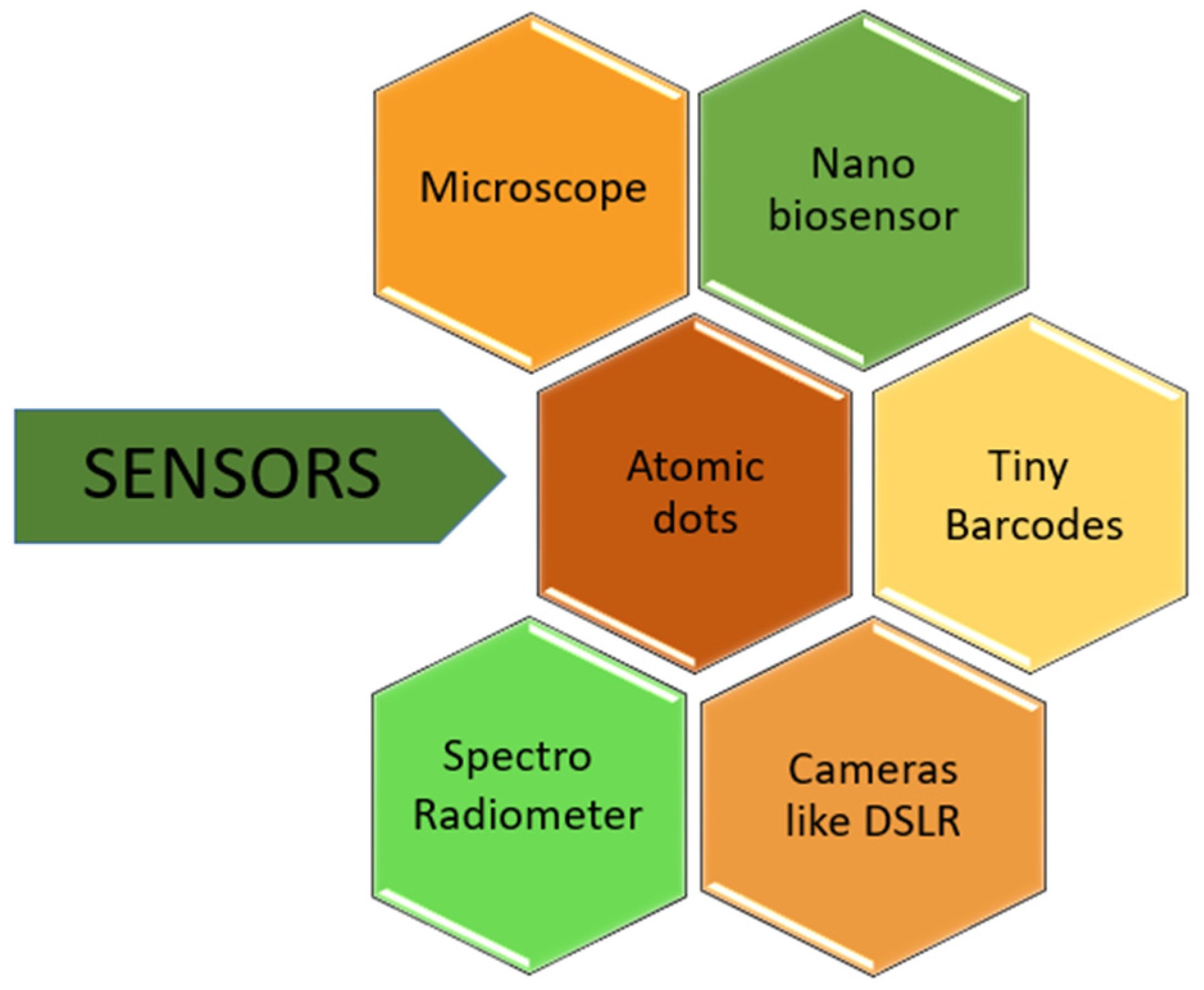Sensing Techniques in Precision Agriculture for Pest and Disease Management †
Abstract
:1. Introduction
2. Remote Sensing (RS) Systems
3. Sensors
- Field sensors: Ambient temperature sensors, image capture, soil-moisture sensors, humidity sensors, and water sensors are used to identify and manage diseases. The soil is also observed using environmental humidity, temperature, and moisture sensors. The findings demonstrated that the crop output is increased with prompt diagnosis and ongoing observation by using advanced techniques.
- Spectroradiometer: An experiment was carried out from 70 to 90 days after seeding that employed a spectroradiometer to identify and quantify the harm caused by T. tobacco (Lind). SVIs were calculated based on the reported canopy reflectance. Remote sensors were used to assess the relationship between a whitefly infestation and biotic stress. In the spectral range of 350–2500 nm at 1 nm, they employed a spectroradiometer with various sample intervals. To ascertain the correlation between the degree of damage caused by the whitefly infestation and chlorophyll content, the chlorophyll concentration was evaluated.
- Microscope: In natural settings, Rothe and Rothe utilized a DSLR camera and a Leica Wild M3C microscope to identify the presence of Myrothecium, Alternaria, and bacterial leaf blight [11].
4. Conclusions
5. Future Outlooks
- Create prediction algorithms to determine the times and locations of disease and insect invasions.
- Prescriptive models should be used to specify methods to manage illness and insect pests.
- Create a system of sophisticated traps made of pheromones to anticipate the invasion of pests.
- Create illness diagnosis models.
- Create models with many detections for disease or insect assaults.
Author Contributions
Funding
Institutional Review Board Statement
Informed Consent Statement
Data Availability Statement
Acknowledgments
Conflicts of Interest
References
- Karimzadeh, R.; Sciarretta, A. Spatial patchiness and association of pests and natural enemies in agro-ecosystems and their application in precision pest management: A review. Precis. Agric. 2022, 23, 1836–1855. [Google Scholar] [CrossRef]
- Bae, S.; Yu, J.; Wang, L.; Kim, J.; Park, C. Experiments on unmanned aerial vehicle survey for detection of micro beach features. J. Coast. Res. 2019, 90, 354–361. [Google Scholar] [CrossRef]
- Zhang, P.; Guo, Z.; Ullah, S.; Melagraki, G.; Afantitis, A.; Lynch, I. Nanotechnology and artificial intelligence to enable sustainable and precision agriculture. Nat. Plants 2021, 7, 864–876. [Google Scholar] [CrossRef] [PubMed]
- Karar, M.E.; Alsunaydi, F.; Albusaymi, S.; Alotaibi, S. A new mobile application of agricultural pest’s recognition using deep learning in cloud computing system. Alex. Eng. J. 2021, 60, 4423–4432. [Google Scholar] [CrossRef]
- Hu, Z.; Xu, L.; Cao, L.; Liu, S.; Luo, Z.; Wang, J.; Li, X.; Wang, L. Application of Non-Orthogonal Multiple Access in Wireless Sensor Networks for Smart Agriculture. IEEE Access 2019, 7, 87582–87592. [Google Scholar] [CrossRef]
- Karar, M.E.; al-Rasheed, M.; Al-Rasheed, A.; Reyad, O. IoT and Neural Network-Based Water Pumping Control System For Smart Irrigation. Inform. Sci. Lett. 2020, 9, 107–112. [Google Scholar]
- Ayaz, M.; Ammad-Uddin, M.; Sharif, Z.; Mansour, A.; Aggoune, E.M. Internet-of-Things (IoT)-Based Smart Agriculture: Toward Making the Fields Talk. IEEE Access 2019, 7, 129551–129583. [Google Scholar] [CrossRef]
- Dhau, I.; Adam, E.; Mutanga, O.; Ayisi, K.K. Detecting the severity of maize streak virus infestations in maize crop using in situ hyperspectral data. Trans. R. Soc. S. Afr. 2018, 73, 8–15. [Google Scholar] [CrossRef]
- Dhau, I.; Adam, E.; Mutanga, O.; Ayisi, K.K.; Mutanga, O. Detection and mapping of maize streak virus using RapidEye satellite imagery. Geocarto Int. 2018, 34, 856–866. [Google Scholar] [CrossRef]
- El-Ghany, A.; Nesreen, M.; El-Aziz, A.; Shadia, E.; Marei, S.S. A review: Application of remote sensing as a promising strategy for insect pests and diseases management. Environ. Sci. Pollut. Res. 2020, 27, 33503–33515. [Google Scholar] [CrossRef] [PubMed]
- Rothe, P.; Rothe, J. Intelligent pattern recognition system with application to cotton leaf disease identification. Innov. Comput. Sci. Eng. 2019, 32, 19–27. [Google Scholar]

Disclaimer/Publisher’s Note: The statements, opinions and data contained in all publications are solely those of the individual author(s) and contributor(s) and not of MDPI and/or the editor(s). MDPI and/or the editor(s) disclaim responsibility for any injury to people or property resulting from any ideas, methods, instructions or products referred to in the content. |
© 2022 by the authors. Licensee MDPI, Basel, Switzerland. This article is an open access article distributed under the terms and conditions of the Creative Commons Attribution (CC BY) license (https://creativecommons.org/licenses/by/4.0/).
Share and Cite
Samreen, T.; Tahir, A.; Sidra-Tul-Muntaha; Nazir, M.Z.; Ahmad, M.; Kanwal, S. Sensing Techniques in Precision Agriculture for Pest and Disease Management. Environ. Sci. Proc. 2022, 23, 16. https://doi.org/10.3390/environsciproc2022023016
Samreen T, Tahir A, Sidra-Tul-Muntaha, Nazir MZ, Ahmad M, Kanwal S. Sensing Techniques in Precision Agriculture for Pest and Disease Management. Environmental Sciences Proceedings. 2022; 23(1):16. https://doi.org/10.3390/environsciproc2022023016
Chicago/Turabian StyleSamreen, Tayyaba, Aimen Tahir, Sidra-Tul-Muntaha, Muhammad Zulqernain Nazir, Muhammad Ahmad, and Sehrish Kanwal. 2022. "Sensing Techniques in Precision Agriculture for Pest and Disease Management" Environmental Sciences Proceedings 23, no. 1: 16. https://doi.org/10.3390/environsciproc2022023016
APA StyleSamreen, T., Tahir, A., Sidra-Tul-Muntaha, Nazir, M. Z., Ahmad, M., & Kanwal, S. (2022). Sensing Techniques in Precision Agriculture for Pest and Disease Management. Environmental Sciences Proceedings, 23(1), 16. https://doi.org/10.3390/environsciproc2022023016





